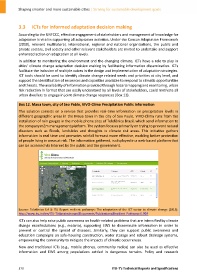Page 580 - Shaping smarter and more sustainable cities - Striving for sustainable development goals
P. 580
3.3 ICTs for informed adaptation decision making
According to the UNFCCC, effective engagement of stakeholders and management of knowledge for
adaptation is vital in supporting all adaptation activities. Under the Cancun Adaptation Framework
(2010), relevant multilateral, international, regional and national organizations, the public and
private sectors, civil society and other relevant stakeholders are invited to undertake and support
enhanced action on adaptation at all levels.
In addition to monitoring the environment and the changing climate, ICTs have a role to play in
cities' climate change adaptation decision making by facilitating information dissemination. ICTs
facilitate the inclusion of multiple voices in the design and implementation of adaptation strategies.
ICT tools should be used to identify climate change related needs and priorities at city level, and
support the identification of resources and capacities available to respond to climatic opportunities
and threats. The availability of information provided through hazard mapping and monitoring, urban
risk reduction in format that are easily understood by all levels of stakeholders, could motivate all
urban dwellers to engage in joint climate change responses (Box 12).
Box 12. Maua town, city of Sao Pablo, VIVO‐Clima Precipitation Public Information
This solution consists on a service that provides real‐time information on precipitation levels in
different geographic areas in the Maua town in the city of Sao Paulo. VIVO‐Clima runs from the
installation of rain gauges in the mobile phone sites of Telefónica Brazil, which send information to
the company m2m management platform. The system focuses primarily on trying to prevent natural
disasters such as floods, landslides and droughts in climate risk areas. This initiative gathers
information in real time and promotes rainfall forecast more effective, enabling better protection
of people living in areas at risk. The information gathered, is displayed in a web‐based platform that
can be accessed via Internet by the public and the government.
Source: Telefónica S.A & ITU Report resilient pathways: The adaptation of the ICT sector to climate change (2013).
http://www.itu.int/en/ITU‐T/climatechange/Documents/Publications/Resilient_Pathways‐E.PDF
ICTs can also help raise public awareness on health‐related problems that are intensified by climate
change manifestations (e.g., malaria), supporting EWS to disseminate information in order to
prevent or control the spread of diseases. Similarly, they can support public awareness and
education campaigns on safe‐housing construction, water storage and robust drainage systems,
empowering the community to mitigate the impacts of climatic occurrences.
New and traditional ICTs (e.g., mobile phones, community radios) can also be used as effective
information and EWS among populations settled in dangerous terrains. Policy and research
570 ITU‐T's Technical Reports and Specifications

